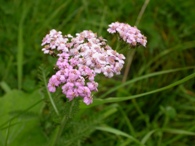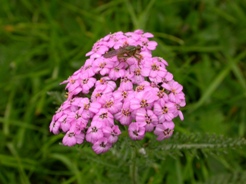 Fascinating Facts
Fascinating Facts
Did you know...?

Greek hero, Achilles, first discovered the healing powers of Achillea millefolium, while during battle. Reportedly he rubbed the herb on his wounded soldiers amidst the battle to staunch their bleeding (Yarrow, 2009).
Although Achillea millefolium is used extensively for its medicinal properties, it does come with its precautions. For instance, Pregnant women shouldn't take Yarrow, because it relaxes the uterus muscles and may cause miscarriage as well as reduced fetal weight (Yarrow, 2009).
The
Cherokee tribes drank Yarrow Tea Steep to reduce
fever and aid in sleep (PLANTS Database,
2011). This steep can be made as
follows:
(PLANTS Database,
2011). This steep can be made as
follows:
-
1-2 tsp. dried herb in 1 cup boiling water.
-
Strain and cool.
-
Drink 3 times per day.
In addition to its use in tea, A. millefolium is used as beer, wine, and soft drink flavoring (Schwartz, 2006).
Herbivores do not often eat the entire Yarrow plant,
only the flowers. This increases its invasiveness.
In fact, Yarrow is very undesirable in cow pastures
because it tends to give the cow's milk a bitter
taste (Schwartz, 2006).

Not a fan of insects? Gather Achillea millefolium! It is an insect repellent (Schwartz, 2006).
To avoid unsightly and uncomfortbale rashes, take Yarrow in moderation! Achillea millefolium has been known to cause photosensitivity, inflammation of the skin induced by the combination of sunlight and A. millefolium, when taken in large quantities (Schwartz, 2006).
Back to Interactions
Where did this information come from? Find out in References!
